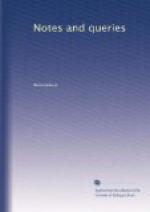BERUCHINO.
Pandects, Florentine Edition of (Vol. ii., p. 421.).—Your correspondent R.G. will find copies of the Florentine edition of the Pandects of 1553, both in the British Museum and in the Bodleian library at Oxford. It is described in the catalogues of both under the title of Pandecta.
C.L.L.
Master John Shorne (Vol. ii., p. 387.).—Mr. Thoms, in his curious notes on this personage, has expressed much regret that fuller details relating to a representation of Magister Johannes Schorn at Cawston, Norfolk, communicated to the Archaeological Institute by the Rev. James Bulwer, had not been preserved in the Archaeological Journal. I believe that the omission was solely in deference to Mr. Bulwer’s intention of giving in another publication the results of his inquiries, and those persons who may desire detailed information regarding Master John will do well to peruse Mr. Bulwer’s curious memoir in the Norfolk Archaeology, vol. ii. p. 280., published March 1849, where representations of the figure at Cawston, and of another at Gateley, Norfolk, are given. There seems to be no evidence that Sir John, although in both instances pourtrayed with nimbus, had been actually canonized and it is deserving of notice that in no ancient evidence hitherto cited is he designated as a Saint, but merely as Master, or Sir John. I am surprised that Dr. Husenbeth, who is so intimately conversant with the examples of hagiotypic symbols existing in Norfolk, should not have given him even a supplementary place in his most useful manual of the Emblems of Saints, recently published. (Burns, 1850, 12mo.) I have sought for Sir John in vain, in either section of that valuable work. It occurs neither under the names of saints, nor in the series of emblems.
ALBERT WAY.
"Her brow was fair" (Vol. ii p. 407.).—The author of the passage quoted by J.M.B. is Barry Cornwall. It occurs in one of the delicious {451} little “Miscellaneous Poems” attached to the volume entitled Dramatic Scenes. The quotation is not quite accurate, the last two words of the first line, “and look’d,” being carried into the second, and thus destroying the metre of both. The Dr. Armstrong alluded to by J.M.B. is, I suppose, a modern celebrity of whom I must plead guilty of being ignorant. The lines could, of course, only occur in the writings of the Dr. Armstrong who wrote The Art of Preserving Health, and who was the friend of the poet Thomson, through the interpolation of some modern editor, within the last thirty years. Barry Cornwall’s poems have never been collected, in this country at least; and as the volume which contains the one in question is to be met with only occasionally, on the book stalls, I send you the entire poem:—
THE MAGDALEN.




